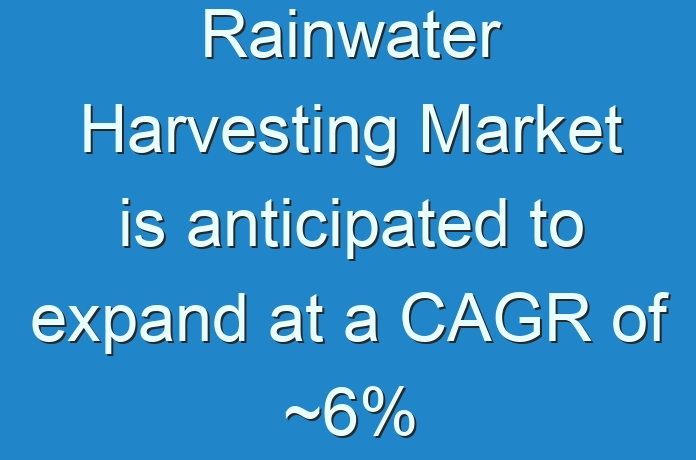
Key Highlights
- In terms of value, the global rainwater harvesting market is anticipated to expand at a CAGR of ~6% from 2019 to 2027
- The earth’s surface is covered with about 70% of water; however, 97% of the total water available on the earth is saline and only 3% of it is fresh water. Out of the total fresh water available, ~70% is in the form of snow cover and glaciers, ~31% is groundwater, and around 0.3% is present in rivers and lakes. Globally, 69% of the water withdrawn is used for agricultural purposes; 23% is employed for industrial purposes; and 8% is used for domestic purposes.
- Demand for fresh water is increasing rapidly across the globe. This has resulted in extensive usage of existing water supplies such as groundwater sources. The level of groundwater has reduced significantly, resulting in scarcity of fresh water. Several countries have started making use of the previously unexploited freshwater sources.
More Trending Reports by Transparency Market Research –
- Rainwater harvesting is a technology utilized to collect rainwater from land surfaces, rooftops, and rock catchments, and storing it for future use. Harvested water has been a good alternative source to fresh water. Additionally, rainwater harvesting is an eco-friendly technology that is also called ‘green practice,’ as it does not hamper the environment.
High Cost of Rainwater Harvesting to Hamper Demand
- In developed countries, rainwater harvesting systems incur high initial investments, which vary depending on the size and technology of the plant. These systems also require regular maintenance. High cost of rainwater harvesting is a major factor that is expected to hamper the global market. It is also anticipated to hinder the adoption rate of rainwater harvesting in various applications.
Request PDF Brochure –
https://www.transparencymarketresearch.com/sample/sample.php?flag=B&rep_id=12482
- Low storage capacity adversely affects the demand for rainwater harvesting, while high storage capacity adds to construction and operating costs, making the technology less economical. This is another key factor estimated to hamper the global market.
Above Ground to be Most Preferred Harvesting Method
- In terms of harvesting method, the above ground segment is expected to expand at a CAGR of 5.5% during the forecast period. The above ground harvesting method has been further sub-segmented into ground surface and storage tank. The above ground harvesting method is primarily preferred in residential, commercial, and agriculture application segments.
REQUEST FOR COVID19 IMPACT ANALYSIS –
https://www.transparencymarketresearch.com/sample/sample.php?flag=covid19&rep_id=12482
High Adoption of Rainwater Harvesting in Commercial Application
- Based on application, the global rainwater harvesting market has been segregated into residential, commercial, industrial, and agriculture
- The commercial segment accounted for more than 40% share of the global rainwater harvesting market in 2018. Rainwater harvesting in commercial projects includes collection of rooftop rainwater, condensate from graywater and air handlers from showers, stormwater runoff, and lavatory sinks and baths. This water is used in various non-potable applications such as irrigation, toilet flushing, and cooling towers.
Buy Now :
https://www.transparencymarketresearch.com/checkout.php?rep_id=12482<ype=S
- Adoption of rainwater harvesting in residential and commercial applications is estimated to overcome water scarcity issues, primarily in regions where additional water resources are scarce and difficult to access. This is another factor that is likely to fuel the demand for rainwater harvesting in the residential segment.
Asia Pacific to be Lucrative Region of Rainwater Harvesting Market
- In terms of consumption, Asia Pacific dominated the global rainwater harvesting market in 2018. The rainwater harvesting market in the region is expected to expand at a rapid pace from 2019 to 2027. Rapid urbanization, rise in population, and strong economic growth are major macroeconomic factors that are anticipated to fuel the demand for rainwater harvesting in the near future. Increase in consumption of rainwater harvesting in applications, such as residential, commercial, and agriculture is also expected to drive the rainwater harvesting market in Asia Pacific. The residential sector in Asia Pacific, particularly in India and China, is likely to witness moderate growth in consumption of rainwater harvesting over the next few years.
- In terms of consumption, Europe is expected to be a prominent region of the global rainwater harvesting market during the forecast period
Rainwater Harvesting Market: Competition Landscape
- The global rainwater harvesting market was highly fragmented in 2018, with numerous manufacturers operating in the market. Kingspan Group, Watts Water Technologies, Inc., Graf Group, Rain Harvesting Supplies, Inc., and Stormsaver accounted for more than 25% share in 2018
- Key players are consistently focusing on the development of high quality rainwater harvesting components with the objective to improve product offerings and gain competitive edge in the global rainwater harvesting market
Key manufacturers operating in the global rainwater harvesting market include:
- Kingspan Group
- Watts Water Technologies, Inc.
- Graf Group
- WISY AG
- Innovative Water Solutions LLC
- D&D Ecotech Services
- Rain Harvesting Supplies, Inc.
- Water Field Technologies Pvt. Ltd.
- Stormsaver
- Climate Tanks
- Water Harvesters
- Heritage Tanks
- HarvestRain
- Rainwater Connection





